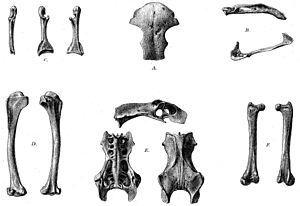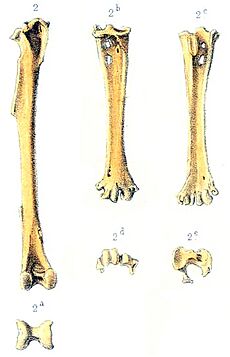Rodrigues scops owl facts for kids
Quick facts for kids Rodrigues scops owl |
|
|---|---|
 |
|
| Fossils | |
| Conservation status | |
| Scientific classification | |
| Genus: |
Otus
|
| Species: |
murivorus
|
| Synonyms | |
|
Strix murivora Milne-Edwards, 1873 |
|
The Rodrigues scops owl (Otus murivorus) was a small owl. It lived a long time ago on the island of Rodrigues. This island is part of the Mascarene islands. Sadly, this owl is now extinct, meaning it no longer exists. It was also known by other names like Rodrigues owl or Leguat's owl.
This owl was one of three special owls from the Mascarene islands. Scientists now place it in the Otus group, which includes many other small owls. The Rodrigues scops owl was much bigger than its relatives in South-East Asia. It grew to be twice as large and four times heavier!
Contents
How Scientists Study the Rodrigues Owl
Scientists learn about extinct animals from old writings and fossils. A man named Julien Tafforet wrote a good description of this owl in 1726. He said it was like the Eurasian scops owl. Tafforet noted that the Rodrigues owl mostly lived in trees. It ate small birds and "lizards," which were probably Rodrigues day geckos. He also wrote that it made a simple call when the weather was good.
Later, scientists found subfossil bones of the owl. These bones helped them understand what the owl looked like. The Rodrigues scops owl was about the size of a large Australian boobook. Female owls could even be as big as a long-eared owl. Like other Otus owls, it had ear tufts. Its legs were almost bare, meaning they had very few feathers.
Naming the Owl
When Milne-Edwards first studied the bones, he thought they belonged to a different type of owl. He called it Strix, which are owls without ear tufts. He also found a larger leg bone. He thought it was from a different, bigger bird.
However, other scientists, Günther and E. Newton, realized something important. Rodrigues is a small island. It's unlikely that two similar owl species would live there at the same time. They correctly guessed that the larger bone belonged to a female Rodrigues scops owl. Female owls are often bigger than males.
Another scientist, Rothschild, thought the larger bone was from a tiny eagle owl. He even gave it a new name, Bubo leguati. But today, scientists agree that Günther and Newton were right. The larger bone was indeed from a female Rodrigues scops owl.
Owl Family Tree
In 2018, scientists did a DNA study. They looked at the DNA from the bones of the Mascarenotus owls. They found that these owls were actually part of the Otus group. This means the Rodrigues scops owl is closely related to other scops owls around the world.
What the Owl Looked Like
Julien Tafforet's description from 1726 helps us imagine this owl:
A bird is seen which is very like the brown owl, and which eats the little birds and small lizards. They live almost always in the trees; and when they think the weather fine, they utter at night always the same cry. On the other hand, when they find the weather bad they are not heard.
This tells us the owl looked like a brown owl. It hunted small birds and lizards. It lived in trees and made a distinct call at night, especially when the weather was good.
Why the Rodrigues Owl Disappeared
The Rodrigues scops owl probably became extinct because of humans and the animals they brought. When people settled on Rodrigues, they changed the island's environment. They also brought rats, which were a big problem. These rats likely ate the owls' eggs and young.
The last time anyone recorded seeing this owl was in 1726. It probably died out in the mid-1700s. Rodrigues is a small island. If the owls were still there in 1761, Pingré, another explorer, would likely have seen them. But he didn't. This suggests the owl was already gone by then.



